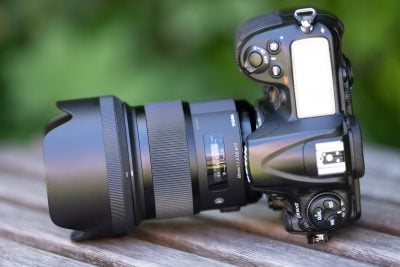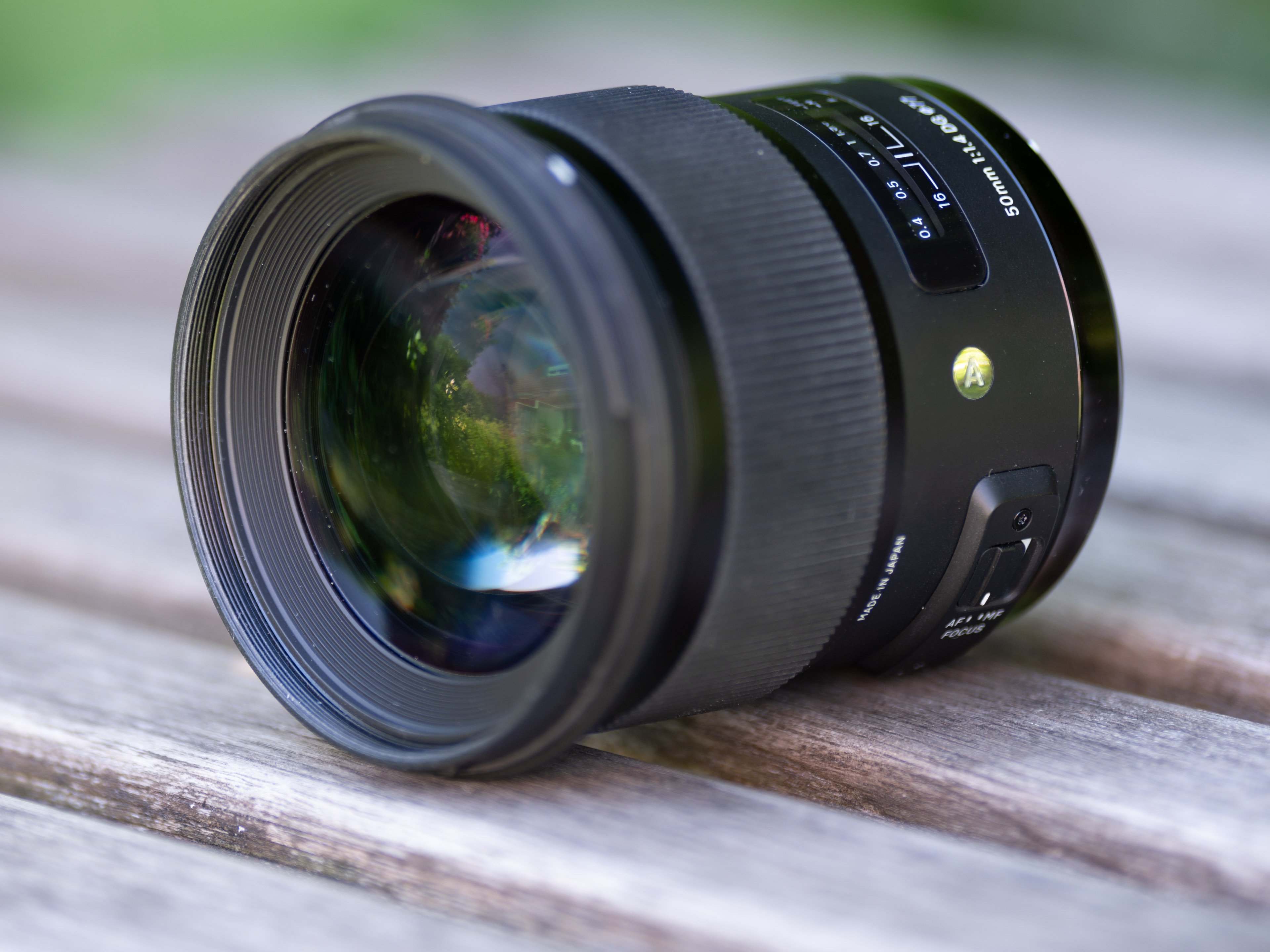
Sigma 50mm f1.4 Art review
-
-
Written by Thomas
Quality
Testing: Longitudinal Chromatic Aberration and focus shift
Lenses with focal ratios of f2.8 or larger are often prone to longitudinal color aberrations (loCA, a.k.a. “axial color” or “Bokeh CA”). These normally show up as magenta coloration in the foreground and greenish hues in the background and are not easily corrected in post-processing. The Sigma 50mm f1.4 Art clearly shows loCA at f1.4 and f2.0. And even at f2.8 the effect is not completely eliminated. The following 100% crops show the foreground on the left and the background on the right with the first crop at f1.4, second at f2.0, third at f2.8:
Longitudinal Chromatic Aberration (loCA)
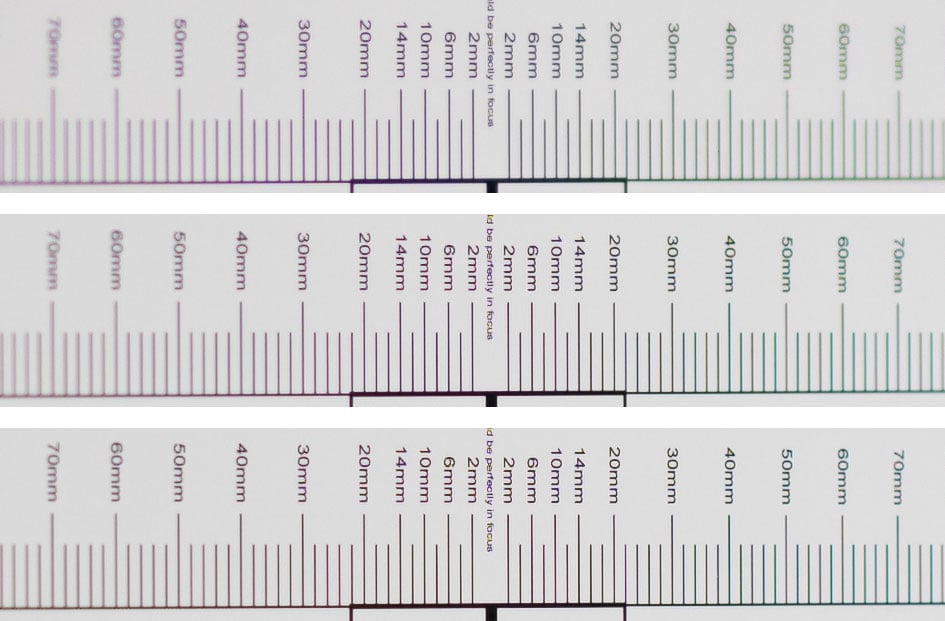
Above: Sigma 50mm f1.4 Art at f1.4, f2.0, f2.8; 100% crops
The following real life shot shows some magenta haloing around high-contrast edges even in the focal plane and a weak green outline around background subjects:

Above: Sigma 50mm f1.4 Art at f1.4; 100% crop; click image to access 4k version
The test also reveals that there is no discernible focus shift. For comparison have a look at the Sony FE 50mm f1.4 ZA (here), Nikon 50mm f1.4G (here), Nikon Z 50mm f1.8 S (here), and the Zeiss Otus 55mm f1.4 (here).
Sharpness and contrast
Let’s have a look at the theoretical performance of the Sigma 50mm f1.4 Art first and compare it to some alternatives:
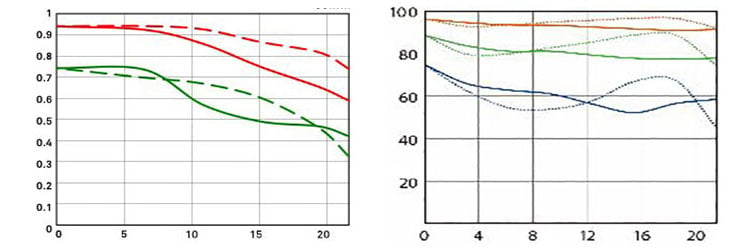
Above: MTF Sigma 50mm f1.4 Art (left), Sony FE 50mm f1.4 ZA (right)
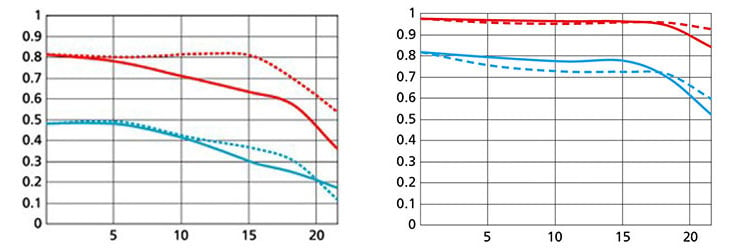
Above: MTF Nikon AF-S 50mm f1.4G (left), Nikon Z 50mm f1.8 S (right)
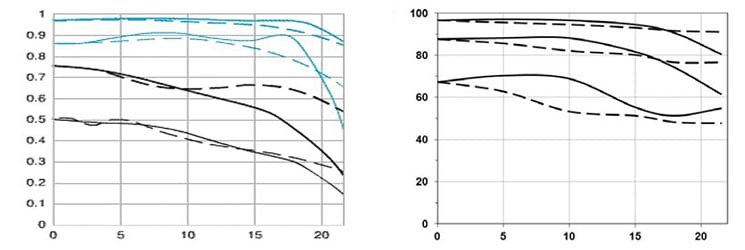
Above: MTF Canon EF 50mm f1.4 (left), Zeiss Otus 55mm f1.4 (right)
The MTF charts show the contrast wide open at 10 line-pairs per mm (in red) and 30 lp/mm (green/petrol). Except for the Sony ZA and the Zeiss Otus where there are 3 pairs of lines for 10 lp/mm, 20 lp/mm, and 40 lp/mm (top to bottom). And in the chart for the Canon lens the petrol lines show 10 lp/mm and 30 lp/mm at f8.0 – so ignore those for the comparison. Higher values are better (more contrast) and the closer the solid and the dotted lines are together the less astigmatism (= resolution depends on the orientation of the test-pattern) the lens has. The x-axis displays the distance from the optical axis (=center of the sensor) in mm.
From the charts the Sigma 50mm f1.4 Art looks clearly better than the lenses directly below it (Nikon AF-S 50mm f1.4G, Canon EF 50mm f1.4) and slightly softer than the lenses on the right side (Sony ZA, Nikon Z 50mm f1.8 S, Zeiss Otus), especially 10mm and more off center. Note: The Z Nikkor profits in this comparison a bit from been shown at f1.8 while all the other lenses are shown at f1.4. But let’s see how this theoretical performance of the lenses translates into real life results in the sharpness test based on Siemens-stars at 4 mm (center), 13 mm (APS-C/DX-corner), and 20 mm (FF/FX-corner) off axis. Processing was done in Lightroom 8/CRAW 11 from RAW to Adobe Color profile. Noise-reduction is set to 0, sharpening to 50/0.5/36/10, with no extra tone, color, or saturation adjustment. White-balance was adjusted to a neutral white and I did some exposure compensation to make the brightness of all crops match. So you will not see light fall-off in the corners.
The following 100% crops show the Sigma 50mm f1.4 Art shot on a 46MP Nikon Z7 with FTZ adapter from f1.4 down to f11.
Sigma 50mm f1.4 Art; 100% crop from center, APS-C-corner, FF-corner

Above: Sigma 50mm f1.4 Art at f1.4

Above: Sigma 50mm f1.4 Art at f2.0

Above: Sigma 50mm f1.4 Art at f2.8

Above: Sigma 50mm f1.4 Art at f4.0

Above: Sigma 50mm f1.4 Art at f5.6

Above: Sigma 50mm f1.4 Art at f8.0

Above: Sigma 50mm f1.4 Art at f11
These 100% crops directly from a 46MP Nikon Z7 sensor show very good sharpness in the center with a gradual roll-off towards the full-frame corner. Stopping down improves performance nicely but you need f5.6 to fully get rid of the astigmatism at the APS-C/DX-corner.
The following comparison shows the Sigma 50mm f1.4 Art, Sony 50mm f1.4 ZA, Nikon Z 50mm f1.8 S, Nikon AF-S 50mm f1.4G, and Zeiss Otus 55mm f1.4 wide open. The Sony ZA was shot on a 42MP Sony A7R II the others on a 46MP Nikon Z7 (via Nikon’s FTZ adapter where needed). Linear resolution of the Nikon Z7 sensor is only 4% higher than from the Sony A7R II sensor which favors the Sony lenses a bit in this comparison but should not make a distinct difference:
Sigma 50mm f1.4 Art; comparison with other lenses wide open

Above: Sigma 50mm f1.4 Art on a Nikon Z7 at f1.4

Above: Sony 50mm f1.4 ZA on a Sony A7R II at f1.4

Above: Nikon Z 50mm f1.8 S on a Nikon Z 7 at f1.8

Above: Nikon AF-S 50mm f1.4G on a Nikon Z 7 at f1.4

Above: Zeiss Otus 55mm f1.4 on a Nikon Z7 at f1.4
In this comparison the Z-Nikkor (at f1.8) and the Zeiss Otus looks best, followed by the Sony 50mm f1.4 ZA, the Sigma 50mm f1.4 Art and finally the Nikon AF-S 50mm f1.4G.
Performance at long distances
The Siemens-star test-targets are shot at a distance of 45x focal length (i.e. at around 2.3m). But as performance of lenses also depends on the shooting distance I did another series of test-shots of a city around 1 km away. Processing was done in Lightroom 8/CRAW 11 from RAW to Adobe Color profile with the lens-profile automatically applied. Noise-reduction is set to 0, sharpening to 50/0.5/36/10, with no extra tone, color, or saturation adjustment. I used autofocus at the largest aperture and did not change focus for other apertures. All shots of the Sigma 50mm f1.4 Art were made on a 42MP Sony A7R II at ISO 100 and image stabilization switched off.
The main image shows the complete scene wide open to give you an impression of the angle of view and to judge vignetting. Following the main image are 100% crops from the Sigma 50mm f1.4 Art from the center, the APS-C-corner and the FF-corner down to f11. You can access the respective full resolution shots up to f11 via the links beneath the main image or by clicking on the respective crops. Please respect our copyright and only use those images for personal use.
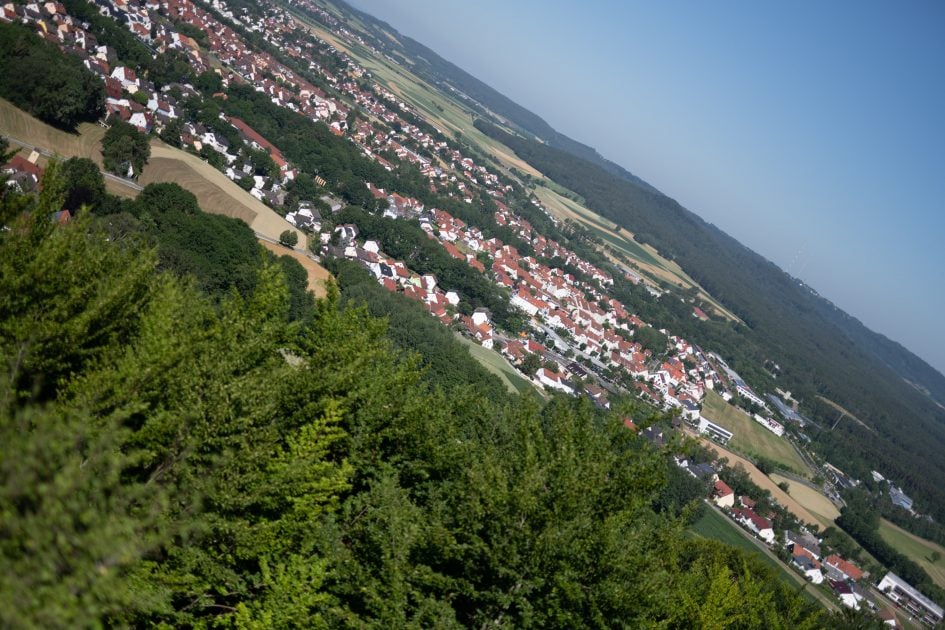
Above: Sigma 50mm f1.4 Art at f1.4; click image for 4k version, also available as large original at f1.4, f1.6, f1.8, f2.0, f2.8, f4.0, f5.6, f8.0, f11

Above: Sigma 50mm f1.4 Art at f1.4; 100% crop from center, APS-C-corner, FF-corner

Above: Sigma 50mm f1.4 Art at f2.0; 100% crop from center, APS-C-corner, FF-corner

Above: Sigma 50mm f1.4 Art at f2.8; 100% crop from center, APS-C-corner, FF-corner

Above: Sigma 50mm f1.4 Art at f4.0; 100% crop from center, APS-C-corner, FF-corner

Above: Sigma 50mm f1.4 Art at f5.6; 100% crop from center, APS-C-corner, FF-corner

Above: Sigma 50mm f1.4 Art at f8.0; 100% crop from center, APS-C-corner, FF-corner

Above: Sigma 50mm f1.4 Art at f11; 100% crop from center, APS-C-corner, FF-corner
Again the Sigma is a bit soft in the APS-C/DX-corner and the FF/FX-corner in this long distance test at f1.4 but not badly so. At f2.8 the lens delivers nice performance and f5.6 produces crisp details across the full-frame sensor
The following comparison shows the Sigma 50mm f1.4 Art, Sony 50mm f1.4 ZA, Nikon Z 50mm f1.8 S, Nikon AF-S 50mm f1.4G, and Zeiss Otus 55mm f1.4 wide open. The Sony ZA was shot on a 42MP Sony A7R II the others on a 46MP Nikon Z7 (via Nikon’s FTZ adapter where needed). All lenses were shot at the same day within minutes. Only the Nikon AF-S 50mm f1.4G was shot another day but under roughly comparable atmospheric conditions:
Sigma 50mm f1.4 Art; comparison with other lenses

Above: Sigma 50mm f1.4 Art at f1.4; 100% crop from center, APS-C-corner, FF-corner; available as large original at f1.4, f1.6, f1.8, f2.0, f2.8, f4.0, f5.6, f8.0, f11

Above: Sony 50mm f1.4 ZA at f1.4; 100% crop from center, APS-C-corner, FF-corner; available as large original at f1.4, f1.6, f1.7, f2.0, f2.8, f4.0, f5.6, f8.0, f11

Above: Nikon Z 50mm f1.8 S at f1.8; 100% crop from center, APS-C-corner, FF-corner; available as large original at f1.8, f2.0, f2.8, f4.0, f5.6, f8.0, f11

Above: Nikon AF-S 50mm f1.4G at f1.4; 100% crop from center, APS-C-corner, FF-corner; available as large original at f1.4, f1.6, f1.8, f2.0, f2.8, f4.0, f5.6, f8.0, f11

Above: Zeiss Otus 55mm f1.4 at f1.4; 100% crop from center, APS-C-corner, FF-corner; available as large original at f1.4, f1.6, f1.8, f2.0, f2.8, f4.0, f5.6, f8.0, f11
In this long distance comparison the Sigma’s center is almost up there with the best. But its APS-C/DX-corner and FF/FX-corner are clearly softer when used wide open than from the the Sony ZA, the Z-Nikkor, and the Zeiss Otus. Still the Sigma is the clearly better performer than the Nikon AF-S 50mm f1.4G.
Rendering of point-light sources at night-shots
Night-shots pose a different challenge for lenses as the contrast is even higher than under bright sun and point-light sources can reveal some weaknesses such as coma, haloing and color-aberrations that do not show up as prominently in other test-shots. The 100% crops below the main image show the effect of coma in the FF-corner of Sigma 50mm f1.4 Art and its companions at various apertures:
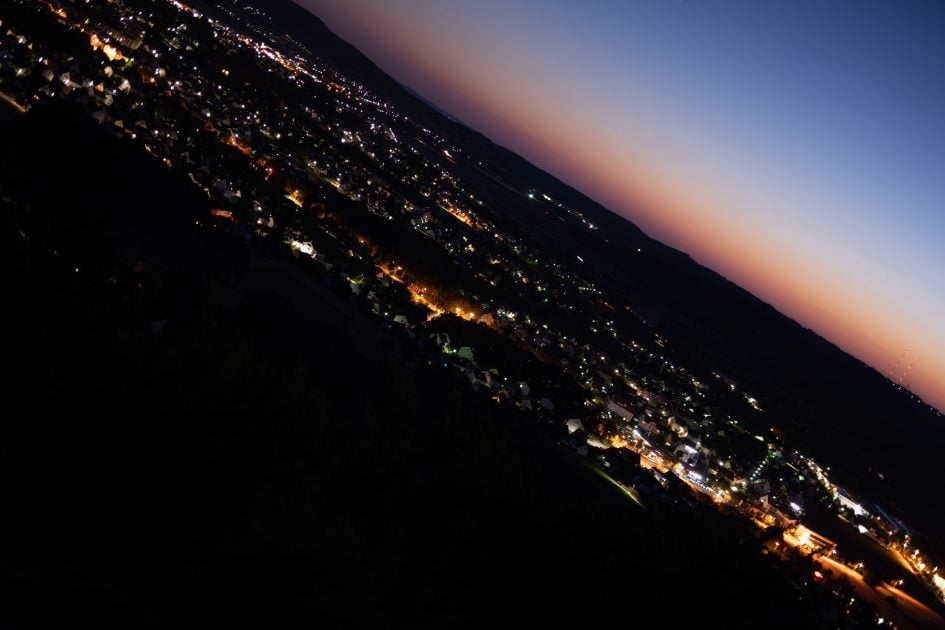
Above: Sigma 50mm f1.4 Art at f1.4; click image for 4k version, also available as large original at f1.4, f2.0, f2.8, f4.0, f5.6, f8.0

Above: Sigma 50mm f1.4 Art; 100% crops from the FF-corner at f1.4 (left), f2.0 (middle), f2.8 (right)

Above: Sony 50mm f1.4 ZA; 100% crops from the FF-corner at f1.4 (left), f2.0 (middle), f2.8 (right)

Above: Nikon Z 50mm f1.8 S; 100% crops from the FF-corner at f1.8 (left), f2.0 (middle), f2.8 (right)

Above: Nikon AF-S 50mm f1.4G; 100% crops from the FF-corner at f1.4 (left), f2.0 (middle), f2.8 (right)

Above: Zeiss Otus 55mm f1.4; 100% crops from the FF-corner at f1.4 (left), f2.0 (middle), f2.8 (right)
Regarding coma the Sony FE 50mm f1.4 ZA is by far the best lens: it almost shows no coma at all! Second best are the Z-Nikkor and the Zeiss Otus. The Sigma Art shows pretty strong coma up until f2.8 but still is clearly better than the F-Nikkor.
Rendering of out-of-focus point-light sources
This test is for the rendering of point-light sources in an out-of-focus background. The circle of confusion that is produced by this test is pretty indicative of Bokeh performance (in the background) and light fall-off. Ideally the out-of-focus image of the point-light is evenly lit and perfectly circular, with no “onion-rings”, and without coloration. Large aperture lenses normally produce an effect known as “cat’s eye” the further away from the optical axis the point-light is projected. This is due to optical vignetting in the lens barrel when light enters the lens from an angle.
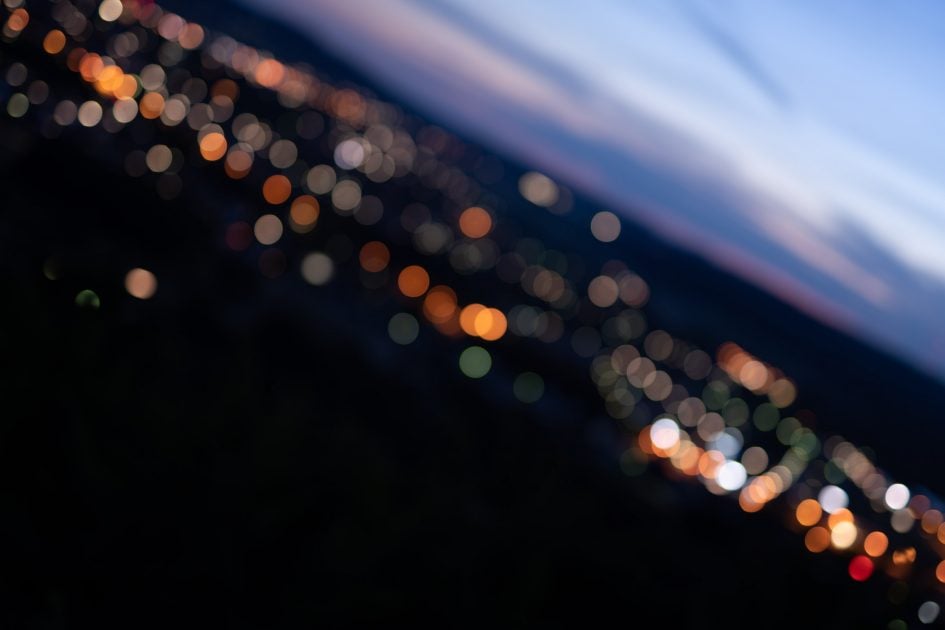
Above: Sigma 50mm f1.4 Art at f1.4; click image for 4k version, also available as large original at f1.4, f2.0, f2.8, f4.0, f5.6, f8.0

Above: Sigma 50mm f1.4 Art on a Nikon Z7 at f1.4; 44% crops from center, APS-C-corner, FF-corner; click image for 4k version, also available as large original at f1.4, f2.0, f2.8, f4.0, f5.6, f8.0

Above: Sony 50mm f1.4 ZA on a Sony A7R II at f1.4; 46% crops from center, APS-C-corner, FF-corner; click image for 4k version, also available as large original at f1.4, f2.0, f2.8, f4.0, f5.6, f8.0

Above: Nikon Z 50mm f1.8 S at f1.8; 44% crops from center, APS-C-corner, FF-corner; click image for 4k version, also available as large original at f1.8, f2.0, f2.8, f4.0, f5.6, f8.0

Above: Nikon AF-S 50mm f1.4G at f1.4; 44% crops from center, APS-C-corner, FF-corner; click image for 4k version, also available as large original at f1.4, f1.8, f2.0, f2.8, f4.0, f5.6, f8.0

Above: Zeiss Otus 55mm f1.4 on a Nikon Z7 at f1.4; 44% crops from center, APS-C-corner, FF-corner; click image for 4k version, also available as large original at f1.4, f1.8, f2.0, f2.8, f4.0, f5.6, f8.0
Compared to the 50mm f1.4 lenses the size of the Bokeh balls from the Zeiss Otus are 10% bigger due to its 55mm focal length while the Z-Nikkor produces 20% smaller Bokeh balls because of its f1.8 focal ratio. Note: If these differences do not exactly show up in the above test-shots that’s due to some imponderables in setting the focus for the shots. The Sigma Art produces very smooth Bokeh balls with no onion-rings and only a moderate amount of outlining developing towards the corners. And the cat’s-eye effect is also very moderate. This looks like good prerequisites for a creamy Bokeh.
Let’s see how this analysis of out-of-focus point-light sources translates into Bokeh-performance shooting a book-shelf.
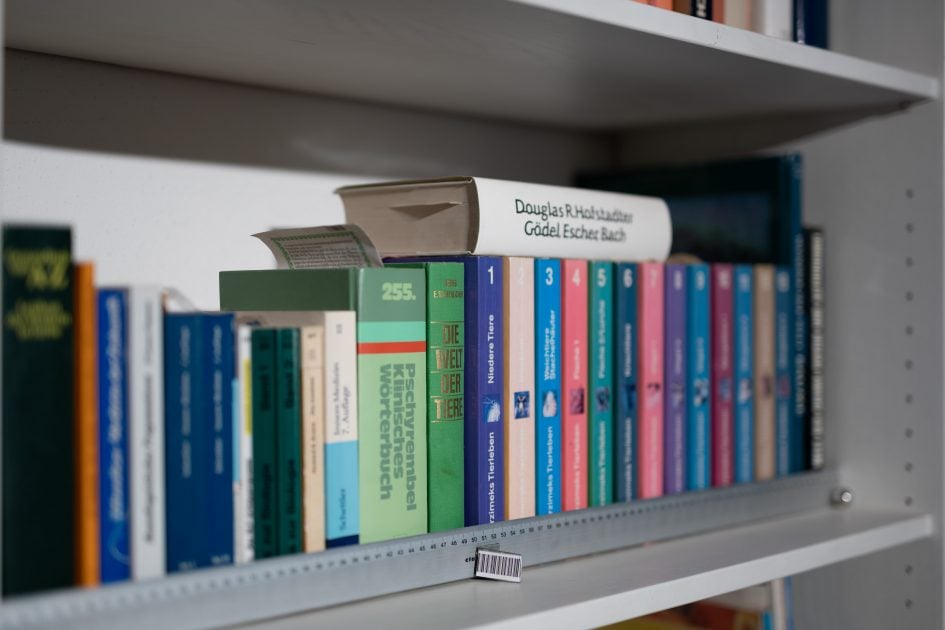
Above: Sigma 50mm f1.4 Art at f1.4; click image for 4k version, also available as large original at f1.4, f1.6, f1.8, f2.0, f2.8, f4.0, f5.6, f8.0

Above: Sigma 50mm f1.4 Art at f1.4; 44% crops from foreground, middle-ground, background; click image for 4k version, also available as large original at f1.4, f1.6, f1.8, f2.0, f2.8, f4.0, f5.6, f8.0

Above: Sony 50mm f1.4 ZA at f1.4; 46% crops from foreground, middle-ground, background; click image for 4k version, also available as large original at f1.4, f1.6, f1.7, f2.0, f2.8, f4.0, f5.6, f8.0

Above: Nikon Z 50mm f1.8 S at f1.8; 44% crops from foreground, middle-ground, background; click image for 4k version, also available as large original at f1.8, f2.0, f2.8, f4.0, f5.6

Above: Nikon AF-S 50mm f1.4G at f1.4; 44% crops from foreground, middle-ground, background; click image for 4k version, also available as large original at f1.4, f1.8, f2.0, f2.8, f4.0, f5.6

Above: Zeiss Otus 55mm f1.4 at f1.4; 44% crops from foreground, middle-ground, background; click image for 4k version, also available as large original at f1.4, f1.6, f1.8, f2.0, f2.8, f4.0, f5.6
In the comparison above the Sigma Art produces perhaps the nicest Bokeh along with the Zeiss Otus and the Z-Nikkor.
Sigma 50mm f1.4 ART vs Canon 50mm f1.4 vs Canon 50mm f1.2
To compare the depth of field and Bokeh of the Sigma 50mm f1.4 ART against the Canon EF 50mm f1.4 and EF 50mm f1.2L, Gordon shot an interior scene using a 20MP Canon EOS 6D with the lens focused on the closest part of the wire clip on the sugar jar in the lower left. The first table show the complete frame, reduced in size to fit on the page here. The second table shows a crop taken from the subject in the lower left corner, and reproduced here at 33%. Finally the third table shows a crop taken from the out-of-focus area in the upper right corner, again reproduced here at 33%.
Let’s start with the first table which again shows the complete frame, reduced to fit on the page here. You may have thought one 50mm lens would render out-of-focus areas in a similar way to another, and that any differences would become invisible at the scale below, but it’s surprising just how much each model has stamped its visible mark on this subject.
You’ll notice the shapes of the out-of-focus lights vary between models with both Canon lenses exhibiting much more of a squashed cat’s eye effect than the Sigma. Technically speaking, a rounder shape is optically superior, although some simply prefer the look of the squashed ovals.
Look closely at the samples from the EF 50mm f1.2 and you’ll also notice how some of the shapes have become cropped-off towards the top of the frame. This clipping effect is often seen on very bright aperture lenses and with the DSLR’s mirror box often to blame. Whatever the reason though, the clipping is visible on the 50mm f1.2 pretty much until closed to f2.8, whereas it’s not apparent on the Canon EF 50mm f1.4 or Sigma 50mm f1.4 ART.

From left to right: Canon EF 50mm f1.4 USM, Sigma 50mm f1.4 Art, Canon EF 50mm f1.2L USM, shot on Canon EOS 6D at f1.4
In the second table below the crops are of the area I focused on. The crops represent a 33% reproduction. The subject was close but within the minimum focusing distance for each lens. In the crops below it’s immediately apparent that the Sigma 50mm f1.4 ART is pretty sharp even at f1.4, whereas its Canon rivals are not. This is with the crops viewed at 33%, and the difference is even more obvious at 100%. It’s not really until the Canons are both closed to around f2.8 that they can deliver a similar degree of sharpness and contrast on a subject at the border at close range. I repeated the test several times to ensure the focus was spot-on and I can confirm the crops below are all in focus.
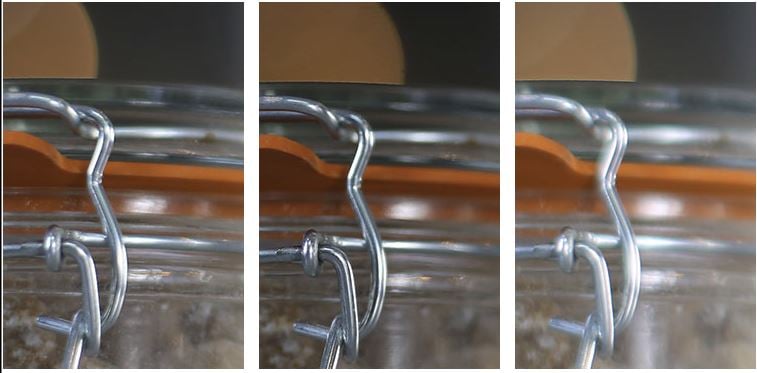
From left to right: Canon EF 50mm f1.4 USM, Sigma 50mm f1.4 Art, Canon EF 50mm f1.2L USM, shot on Canon EOS 6D at f1.4
The Canons perform much better in the middle at larger apertures, which will be fine if you’re shooting portraits, but if you’re shooting anything with detail at the borders at close range, the Sigma visibly out-performs the Canon EF 50mm f1.4 and EF 50mm f1.2 at apertures larger than f4.
In the table below crops are from the area in the upper right of the image for a closer look at the out-of-focus areas. The crops are shrunk to represent a 33% reproduction here. The cat’s eye / squashed oval effect is again more apparent on the two Canon lenses, although the Sigma isn’t completely immune in the far corners. If you look back at the first table with the complete frames though, you can see how the Sigma avoids the effect away from the far corner, whereas they’re visible across more of the frame on the Canons.
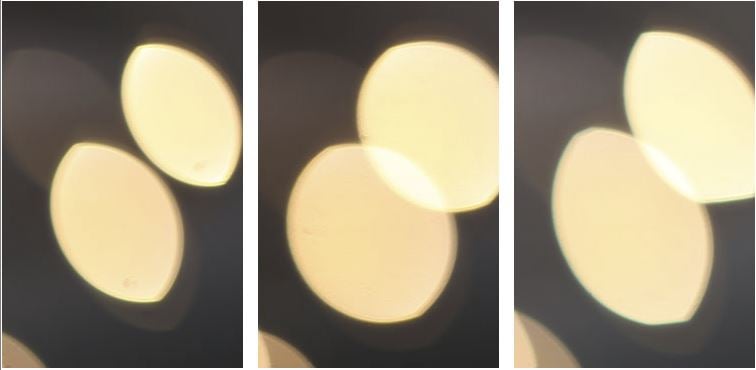
From left to right: Canon EF 50mm f1.4 USM, Sigma 50mm f1.4 Art, Canon EF 50mm f1.2L USM, shot on Canon EOS 6D at f1.4
The clipped shape is also more apparent on the crops from the 50mm f1.2, and to me it’s quite distracting and a downside of this lens design on a DSLR. I also think the Sigma maintains a more circular shape as the aperture is closed. The good news is all three avoid the onion-ring effect of concentric rings inside the blobs, and there’s no coloured fringing to complain about on any of them either. But ultimately I think the Bokeh is smoother and better-rendered on the Sigma, and the in-focus areas are sharper too. This is expected when compared against the EF 50mm f1.4 which is less than half the price, but impressive compared to the EF 50mm f1.2 which is comfortably more expensive.
Portrait performance
50mm focal length may not be the classical choice for portraits on a full-frame camera but the Sigma 50mm f1.4 Art can well be used for upper body or full body shots or offers an angle of view equivalent to an 80mm lens on a cropped APS-C sensor. And the background blur at closer shooting distances is nice enough to give it a try. All shots were done from the same position/distance so perspective does not change between shots. But due to the slightly different focal lengths of the lenses and different sensor resolutions of the cameras the images and crops show a little different framing and magnification. There are also some slight focus-differences which inevitably occur when you shoot a living, breathing subject.
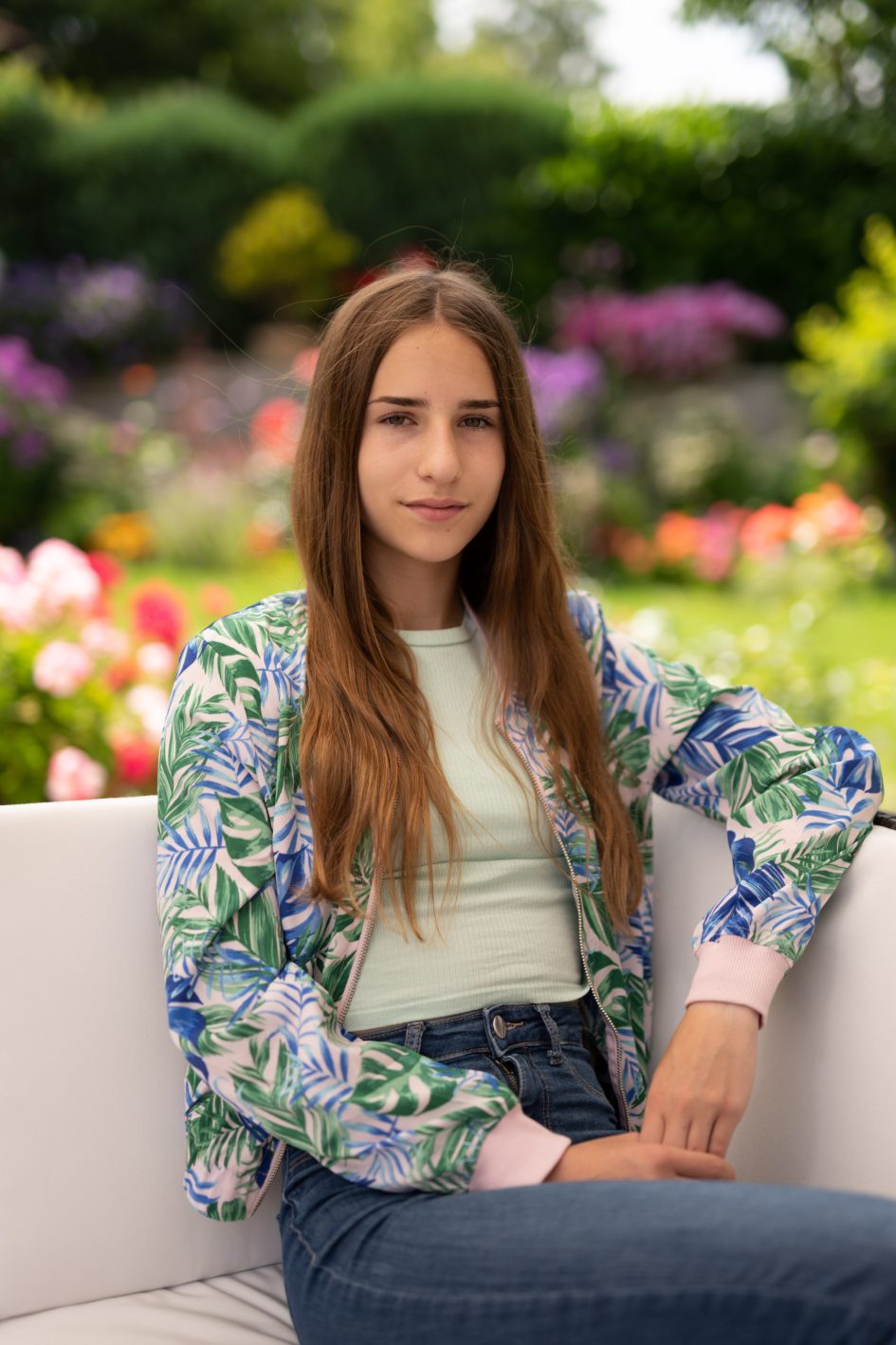
Above: Sigma 50mm f1.4 Art at f1.4; click image for 4k version, also available as large original at f1.4, f1.8, f2.0, f2.8

Above: Sigma 50mm f1.4 Art on a Nikon Z7 at f1.4, 50% crop; click image to view 100% crop, also available as large original at f1.4, f1.8, f2.0, f2.8

Above: Sony 50mm f1.4 ZA on a Sony A7R II at f1.4, 50% crop; click image to view 100% crop, also available as large original at f1.4, f1.7, f2.0, f2.8

Above: Nikon Z 50mm f1.8 S on a Nikon Z7 at f1.8, 50% crop; click image to view 100% crop, also available as large original at f1.8, f2.0, f2.8

Above: Zeiss Otus 55mm f1.4 on a Nikon Z7 at f1.4, 50% crop; click image to view 100% crop, also available as large original at f1.4, f1.8, f2.0, f2.8
Background blur is the nicest from the Zeiss Otus which also produces a very smooth transition in the model’s hair. The Sigma Art comes second with the Sony ZA and the Z-Nikkor both look a bit nervous. Taking the slightly lower magnification of the Sigma Art compared to the Zeiss Otus into account the Sigma Art might even produce the softest background blur.
Next check out my sample images!
Check prices on the Sigma 50mm f1.4 Art at Amazon, B&H, Adorama, or Wex. Alternatively get yourself a copy of my In Camera book or treat me to a coffee! Thanks!




